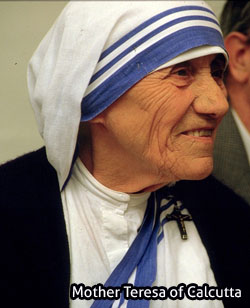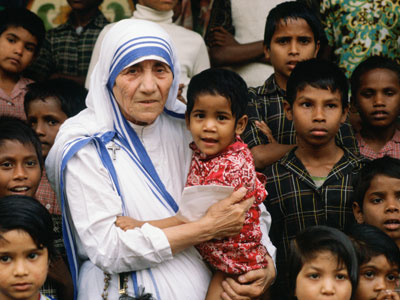德蕾莎修女 (Mother Teresa of Calcutta)
Posted on Friday, April 20th, 2012 and under 其他.Warning: Undefined variable $before in /home3/myrunners/public_html/itudia.com/share/wp-content/themes/sim/single.php on line 19
Warning: Undefined variable $sep in /home3/myrunners/public_html/itudia.com/share/wp-content/themes/sim/single.php on line 19
Warning: Undefined variable $after in /home3/myrunners/public_html/itudia.com/share/wp-content/themes/sim/single.php on line 19
Tags: 德蕾莎修女
 真福德兰修女,(Blessed Teresa of Calcutta,1910年8月27日-1997年9月5日,中国大陆、台湾译作德蕾莎修女,港澳译作德兰修女,又译作德肋撒修女、泰瑞莎修女),著名 天主教慈善工作家,主要替印度加尔各答的穷人服务,于1979年被授予诺贝尔和平奖。 2003年10月,教宗若望·保禄二世把她列入天主教宣福名单。德兰修女也有「加尔各答的天使」的美誉。
真福德兰修女,(Blessed Teresa of Calcutta,1910年8月27日-1997年9月5日,中国大陆、台湾译作德蕾莎修女,港澳译作德兰修女,又译作德肋撒修女、泰瑞莎修女),著名 天主教慈善工作家,主要替印度加尔各答的穷人服务,于1979年被授予诺贝尔和平奖。 2003年10月,教宗若望·保禄二世把她列入天主教宣福名单。德兰修女也有「加尔各答的天使」的美誉。
德兰修女的本名是艾格尼丝·刚察·博亚丘(Agnes Gonxha Bojaxhiu),她是一个出生于奥斯曼帝国科索沃省的斯科普里(前南斯拉夫联邦马其顿共和国的首都)的阿尔巴尼亚裔人。就在斯科普里老城石桥附近。父 亲尼古拉(Nikolla Bojaxhiu)是成功的地方杂货承包商,母亲名为Dranafila Bojaxhiu,她是么女,上有哥哥和姐姐(姐姐后来也成为修女)。家中说阿尔巴尼亚语,是天主教家庭,她所居住的城市多为穆斯林和东正教信徒,仅有少 数的天主教徒。
德兰修女出生的那一年,正好阿尔巴尼亚人起来叛乱。两年后巴尔干战争爆发,1914年第一次世界大战爆发。
德兰修女很少提到她的童年生活。 8岁(1918年)时父亲去世,母亲肩负起整个家庭的担子和照顾三个小孩的责任。 10岁(1920年)时她到克罗埃西亚读书。她曾说,在12岁加入一个天主教的儿童慈善会时,她就感觉自己未来的职业是要帮助贫寒,15岁时,她和 姐姐决定到印度接受传教士训练工作,18岁时,她进了爱尔兰罗雷托修会(Sisters of Loreto),并在都柏林及印度大吉岭接受传教士训练工作,三学期后,德蕾莎修女正式到了印度的加尔各答,在圣玛莉罗雷托修会中学担任教职,主要是教地 理。 1931年,德兰正式成为修女,1937年5月更决定成为终身职的修女,并依法国19世纪最著名的修女圣女德莉莎(Saint Teresa)的名字和精神,改名为德兰修女。 1940年代初期,德兰修女在圣玛莉罗雷托修会中学担任校长一职,但当时印度贫富差距非常大,校内一片安宁,但校外却满街都是无助的麻疯患者、乞丐、流浪 孩童。 1946年9月10日,德兰修女到印度大吉岭的修院休息了一年,并强烈的感受到自己要为穷人服务的心,返回加尔各答后,她向当地的总主教请求离开学校和修 会,但一直得不到许可。
1947年东巴基斯坦脱离印度独立,加尔各答涌入了数以万计的难民,大多数都是怕被回教徒迫害的印度教徒,传染病如霍乱和麻疯病没有受到控制,在街头巷尾 爆发开来,于是加尔各答的街头,学校的高墙外越来越像是地狱,折磨着德兰修女的心,在不断向总主教以及梵蒂冈请求下,1948年,教宗庇护十二世终于给德 兰修女以自由修女身分行善的许可。并拨给她一个社区和居住所让她去帮助有需要的穷人。德兰修女马上去接受医疗训练,并寻找帮手,1950年10月,德兰修 女与其他12位修女,成立了仁爱传教修女会(Missionaries of Charity;又称博济会,仁爱之家),并将教会的修女服改为印度妇女传统的沙龙,以白布镶上朴素的蓝边,成为博济会修女的制服。

Mother Teresa (August 26, 1910 – September 5, 1997), born Agnesë Gonxhe Bojaxhiu (pronounced [aɡnɛs ɡɔnˈdʒa bɔˈjadʒju]), was an Albanian Roman Catholic nun with Indian citizenship who founded the Missionaries of Charity in Kolkata (Calcutta), India in 1950. For over 45 years she ministered to the poor, sick, orphaned, and dying, while guiding the Missionaries of Charity’s expansion, first throughout India and then in other countries.
By the 1970s she was internationally famed as a humanitarian and advocate for the poor and helpless, due in part to a documentary, and book, Something Beautiful for God by Malcolm Muggeridge. She won the Nobel Peace Prize in 1979 and India’s highest civilian honour, the Bharat Ratna, in 1980 for her humanitarian work. Mother Teresa’s Missionaries of Charity continued to expand, and at the time of her death it was operating 610 missions in 123 countries, including hospices and homes for people with HIV/AIDS, leprosy and tuberculosis, soup kitchens, children’s and family counselling programs, orphanages, and schools.
She has been praised by many individuals, governments and organizations; however, she has also faced a diverse range of criticism. These include objections by various individuals and groups, including Christopher Hitchens, Michael Parenti, Aroup Chatterjee, Vishva Hindu Parishad, against the proselytizing focus of her work including a strong stance against abortion, a belief in the spiritual goodness of poverty and alleged baptisms of the dying. Medical journals also criticised the standard of medical care in her hospices and concerns were raised about the opaque nature in which donated money was spent.
Following her death she was beatified by Pope John Paul II and given the title Blessed Teresa of Calcutta.

